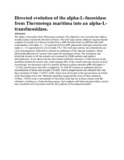| dc.description.abstract | The alpha-L-fucosidase from Thermotoga maritima (Tm alpha fuc) was converted into alpha-L-transfucosidase variants by directed evolution. The wild-type enzyme catalyzes oligosaccharide synthesis by transfer of a fucosyl residue from a pNP-fucoside donor to pNP-fucoside (self-condensation) with alpha-(1-->3) regioselectivity or pNP-galactoside (transglycosylation) with alpha-(1-->2) regioselectivity at low yields (7%). The wild-type enzyme was submitted to one cycle of mutagenesis, followed by rational recombination of the selected mutations, which allowed identification of variants with improved transferase activity. The transferase and hydrolytic kinetics of all the mutants were assessed by NMR methods and capillary electrophoresis. It was shown that the best mutant exhibited a dramatic 32-fold increase in the transferase/hydrolytic kinetic ratio, while keeping 60% of the overall wild-type enzyme activity. Accordingly, the maximum yield of a specific transglycosylation product [pNP-Gal-alpha-(1-->2)-Fuc] reached more than 60% compared to 7% with WT enzyme at equimolar and low concentrations of donor and acceptor (10 mM). Such an improvement was obtained with only three mutations (T264A, Y267F, L322P), which were all located in the second amino acid shell of the fucosidase active site. Molecular modeling suggested that some of these mutations (T264A, Y267F) cause a reorientation of the amino acids that are in direct contact with the substrates, resulting in a better docking energy. Such mutants with high transglycosidase activity may constitute novel enzymatic tools for the synthesis of fucooligosaccharides. | en |

